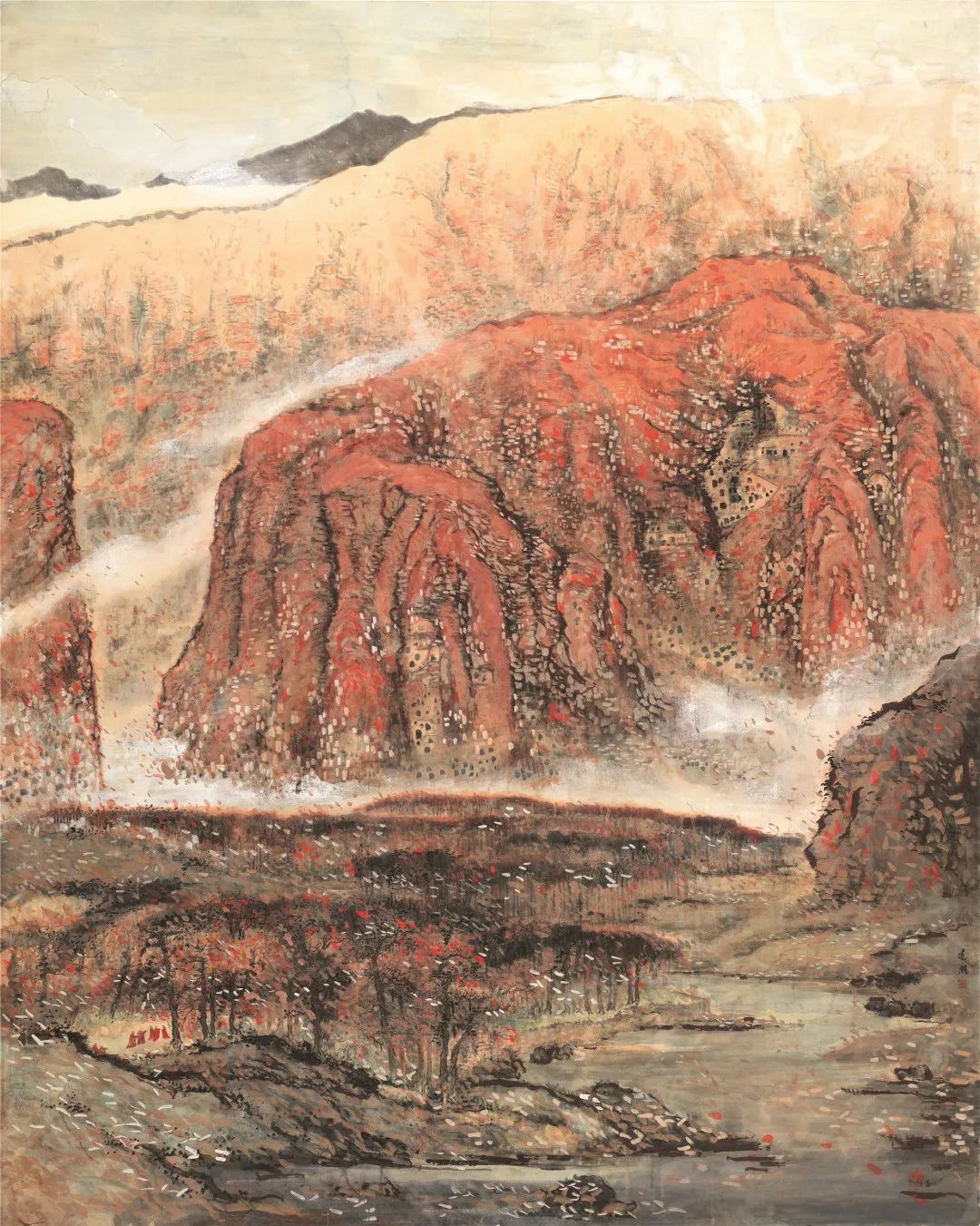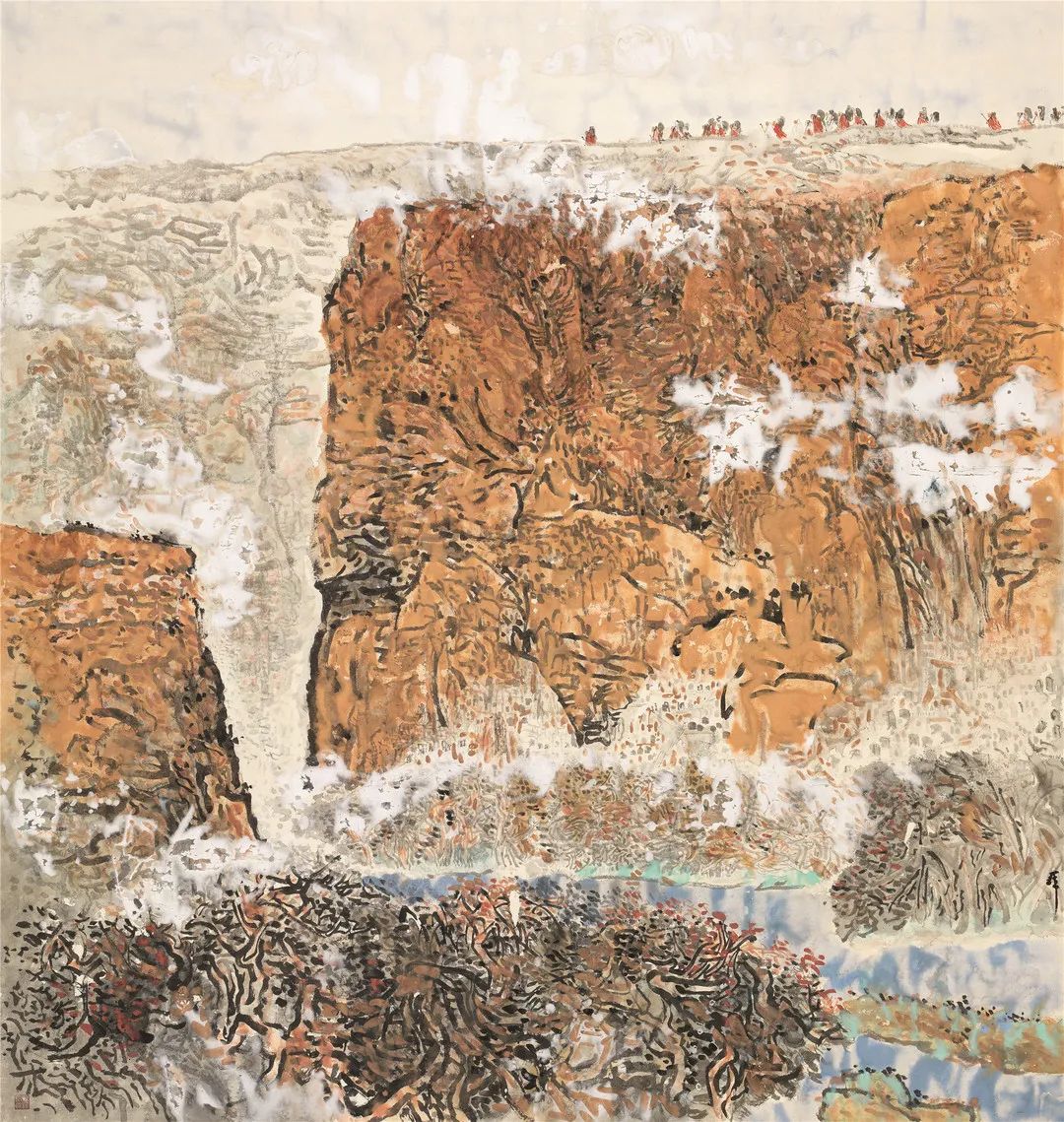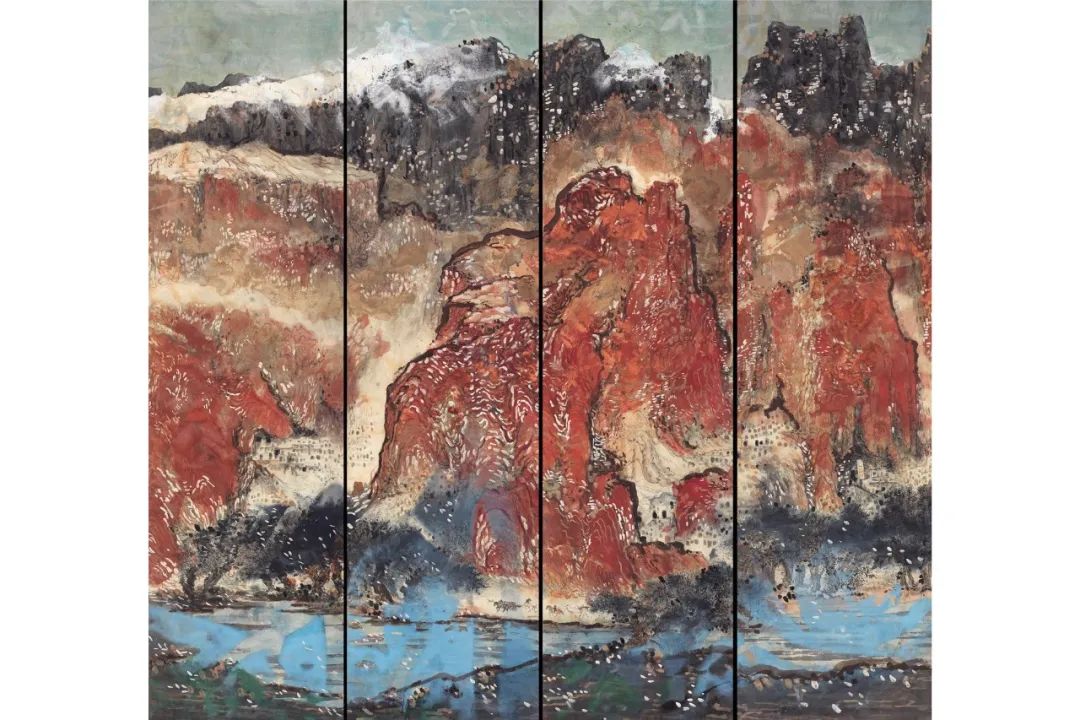
朝圣—丝绸之路主题展
展览地点:红螺书院(北京怀柔红螺寺旁)
展览时间:2020年6月30日-10月31日
主办:北京红螺书院
协办:永嘉楠溪书院
浙江箬溪精舍
英国伦敦书院
这是一场以丝绸之路和中华文化发展为线索的交流展,呈现了西域山川的博大与世界文明的交融,是艺术与文明的双重思考。
展览的形式有很多,这是一次长时间的沙龙式的交流展,中途也会增加或减少作品,以期给观者不同的文化感受与期待。

西域佛地 纸本设色 195x186cm 纸本设色 2012-2014年

西域秋旅 纸本设色 265×210Cm 2011-2018年
周建朋《辉煌的龟兹》
文/陈航
《辉煌的龟兹》是建朋一系列表现丝路主题的作品之一,这些作品的产生与其深沉的新疆情结密切关联,新疆师大美术学院执教6年的教学经历,使建朋对“丝绸之路”的人文及地理的理解全然不同,同时执教过程中承担的多项新疆本土美术的相关研究以及中亚美术研究资料库建设项目等,让建朋还触及到了新疆以外更广阔的“西域”地域,作为以绘画创作为主体的年靑艺术家,在对新疆及其以外的西域美术研究中,不仅建立了理论的积淀,更在自己的创作思考与题材萃取上找到了支点。

柏孜克里克石窟印象26.8x190 x6cm 纸本设色 2020年

西域朝圣三189x199cm 纸本设色 2020年
近些年,建朋创作了大量的丝路题材作品,个展不断,有丈八巨幅,也有小品,有水墨,也有重彩。建朋书画兼修,亦能治印,作为浙江人骨子里带着的那种文人情致,也交织在了他近年的作品中,形成了周建朋在绘画风格上的取向与方式:一方面努力地表现西域丝路的历史与现实情境,另一方面又不舍于既有的文人品韵,西域苍凉与疏野的特质,建朋更愿以优雅的方式讲述,且伴有大量的诗文题跋,所以建朋笔下的丝路意造是一种别具的方式阐释。

帕米尔行 纸本设色 160x190cm 2018年

王维渭城曲诗意97x102.5cm 纸本青绿设色 2020年
近日,建朋向笔者展示了他的新作《辉煌的龟兹》,我感到这应是建朋在不断纯化作品地域性的新进展,在许多的方面全然改变了上文所述作品的一贯性,笔者在其中读出了建朋的努力。如果熟悉《辉煌的龟兹》所表现的主题,便能从画中感受到那种“克孜尓”遗韵被建朋很有意思地呈现了出来。笔者曾数谒其地,数入龟兹(今库车),每感世事兴衰,千年一瞬,古龟兹国消失于约公元14世纪,佛教在此曾兴盛千年,而今安在?龟兹承载了太多的西域往事与变迁,克孜尓佛窟泥墙上依稀的壁画与尘土相交织,给今人残留了龟兹的远古气息。看到建朋作品取名《辉煌的龟兹》,知其寓意,亦能同怀,我注意到,作品是以写意的笔调完成,但所凭借的却是纯正的岩彩重作色,完全不是水墨的意趣,更没大量的题款,画面单纯,造境呈现着“克孜尔”地域整体气象,大量土红色的运用暗示着“克孜尔”(维语:红色)的含义,佛窟被安排于画面并不显眼的下方山壁间,很显然作者意图并非经意于对千年遗迹的详细描述,而是让画面更多地充斥着高垒的西域“尘土”,写意的手法还使一切都变得不确定和不具体,而本身就是“尘土”的岩彩厚塗法的运用将画面的寓意延伸至视觉的表象,笔者很明确的是,建朋作品的创意正在这里,“辉煌的龟兹”的主题与画面表现的择取形成了内容上的反差。笔者从吐鲁番伯孜克里克千佛洞到龟兹克孜尔千佛崖,每当心怀敬意,仰瞻窟壁,努力找寻着历史的蛛丝马迹,而最终在心灵深处留下的记忆,正是这种从尘土中偶尔唤醒的往昔和泯灭着往昔的尘土。

葱岭余晖 绢本设色 220×100 cm 2016年

昆仑山行 绢本设色 45x55cm 2019年
Zhou Jianpeng “The Glorious Qiuci”
Chen Hang
"The Glorious Qiuci" is one of Jianpeng's series of works that express the theme of the Silk Road. The creation of these works is closely related to his deep affection for Xinjiang. The 6-year teaching experience of the Xinjiang Normal University Academy of Fine Arts has made Jianpeng have completely different humane and geographic understandings about “Silk Road”. At the same time, he has undertaken a number of researches on Xinjiang's local arts and the construction project of the Central Asian Art Research Database, etc., which allowed Jianpeng to reach the broader "Western Region" outside Xinjiang. As a young artist who majors in painting, has not only established the accumulation of theory in the study of fine arts in Xinjiang and other western regions, but also found a fulcrum in his creative thinking and theme choosing.

敦煌石窟 纸本设色 213x269cm 纸本设色 2016-2020年

克孜尔尕哈 绢本设色 133x128cm 2020年

胡杨牧放图 纸本设色 215x81cm 2018年
In recent years, Jianpeng has created a large number of works on the theme of the Silk Road. His personal exhibitions have been held one after another, including huge and small paintings, sketches, ink paintings, and color paintings. Jianpeng's also good at both calligraphy and painting, besides, he knows about seal carving arts well. As a Zhejiang people who has the literati sentiment in his blood, which has also interwoven in his works in recent years, and it has formed Zhou Jianpeng's option and style in painting: on the one hand, he strives to express the historical and realistic situation of the Silk Road in western region, on the other hand, he is not reluctant to give up the qualities of the literati that existed, the desolation and wildness of the western regions, Jianpeng prefers to tell it in an elegant way, and the works are accompanied by a large number of poems or words, so the creation of the Silk Road in Jianpeng's works is a unique way of interpretation.

卢舍那 绢本设色180x66cm 2020年

人生莫作远行客 绢本设色205x83cm 2019年

宇宙洪荒 绢本设色 205x83cm 2020年
Recently, Jianpeng showed the author his new work “The Glorious Qiuci”. I feel that this should be the new development of Jianpeng's continuous purification of the region of the work, which has completely changed the consistency of the works mentioned above in many aspects. I can see Jianpeng's efforts in it. If you are familiar with the theme expressed in "The Glorious Qiuci", you can feel the aftertaste of "Kezier" in the painting, which is interestingly presented by Jian Peng. The author has been there several times and entered into Quici (now Kuqa). Every time I can feel the world has experienced the rise and fall, thousands of years has passed like a moment, the ancient Qiuci disappeared in about the 14th century AD. Buddhism has flourished here for thousands of years, but where is it now?

天山碧池 纸本设色 142x183cm 2019年

麦积山 金笺青绿设色 112x72cm 纸本青绿设色 2018-2020年

昆仑山居 纸本青绿设色 189x158cm 2016-2020年
Qiuci has been through too much of the past events and changes of the western region. The faint murals on the mud walls of Kezier Buddha Cave interweave with the dust, leaving the ancient atmosphere of Qiuci to the present. When I saw Jianpeng ’s work named “The Glorious Qiuci”, I knew its meaning, and I could share my feelings with him. I noticed that the work was done in freehand style, but it relied on pure mineral heavy color painting. It is not ink painting, and there are not a lot of inscriptions. The picture is simple, and the landscape shows the overall atmosphere of the "Kezier" region. The much use of earth red color implicates the meaning of "Kizil" (Uighur: red), Buddha caves are arranged between the unobtrusive mountains below in the picture. Obviously, the painter’s intention was not to deliberately describe the “dust” of thousand-year-old ruins in detail, but to make the picture more full of the high ramparts in the western region. Everything becomes uncertain and unspecific by the use of freehand brushwork, and the application of the thick paint method of mineral color, which is, just "dust" that extends the meaning of the picture to the visual appearance. The author is very clear that the creativity of Jianpeng's work lies here. The theme of “The Glorious Qiuci” and the choice of the picture expression form a contrast in the content. The author traveled from the Thousand Buddha Caves in Turpan Bezeklik to Thousand Buddha Cliffs of the Guizikizil. I showed my respects every time I looked up at the cave walls, and tried to find the traces of history, and finally it left the memory deep in my heart. It is this past that occasionally awakened from the dust and the dust that wiped out the past.

古格 纸本设色96x355cm 2020年

扎什伦布寺 纸本设色74x48cm 2011-2018年

朔望 纸本设色 201x143cm 2020年

《辉煌的龟兹》 绢本设色 232×242cm 2011-2018年
Comment